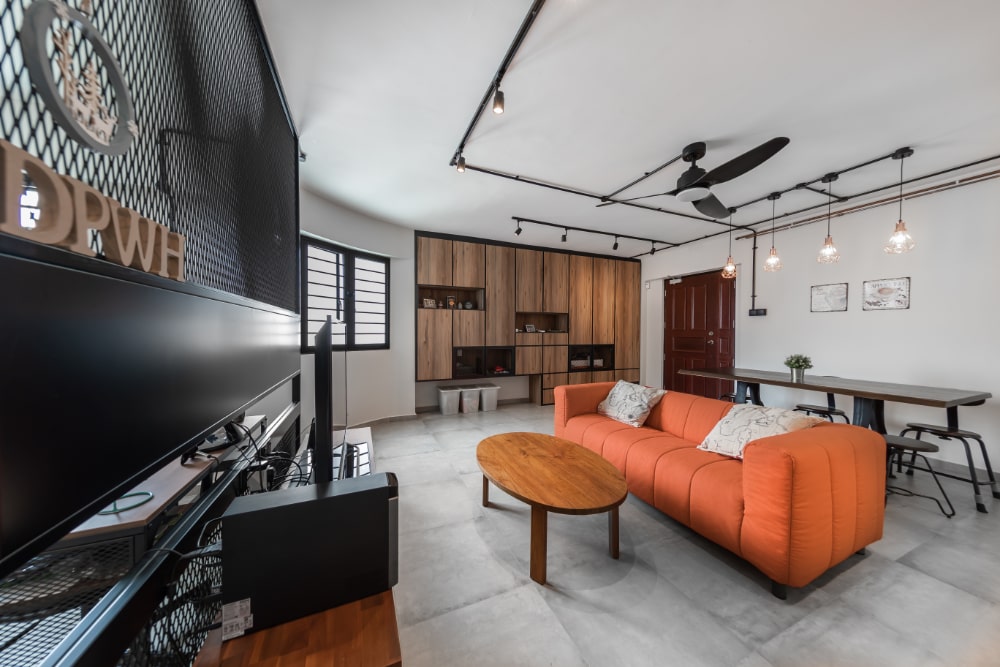A Comprehensive Guide to Contemporary Interior Design for Singapore Homes
Contemporary interior design represents the here and now, embracing trends, styles, and materials of our day. Unlike “modern” design, which refers to a particular time which can generally fall within the early to mid-20th century, contemporary design is ever-changing. It reflects today’s culture, technology, and lifestyle of the world.
The signature of contemporary interior design is its minimalism: open spaces, clean lines and a neutral colour palette. The design invites a feeling of order, simplicity, and functionality, making spaces that are both calming and inviting.
While modern design is more fixed and rooted in early to mid-20th-century aesthetics, contemporary styles leans more toward fluidity. Borrowing from many other designs, such as mid-century modern, minimalist, and even industrial, the overall aim is to make the design cohesive and streamlined, firmly set in the present.

Contemporary Interior Design Style vs. Other Styles
Although contemporary interior design style is often confused with modern interior design, they differ. Modern design pertains to a certain period of time, like mid-century modern, while the style of contemporary design changes and evolves to keep up with the present times. This means that even though a mid-century modern design would be considered modern interior design, it wouldn’t be considered contemporary.
Traditional interior design is quite different from contemporary interior design. Traditional designs focus on darker woods, richer colours, and intricate details. In contrast, contemporary interiors bank on simplicity and the use of neutral colours and modern materials.
Key Characteristics of Contemporary Interior Design
Understanding the characteristics of contemporary interior design can help you understand how to bring the style into your home. Some of the defining characteristics include:
Clean Lines and Open Spaces
One of the strongest inferences about contemporary style in the present day is how clean the lines can be. Many spaces are free, open, and airy, tending to have furniture and design elements that are straightforward and functional without excessive ornamentation. Emphasis is placed upon creating openness and flow within a space; thus, rooms are made to feel airy and uncluttered.
In contemporary interiors, furniture tends to be made of straight, geometric lines with a minimum of ornamentation. In contrast to the more traditional, ornate designs, furniture is sleek and understated.
Neutral Colour Palette with Bold Accents
Contemporary interior design uses neutrals including greys, blacks, whites, and beiges. These colours provide a blank backdrop that easily accommodates bold colourful accents and art pieces. Neutral tones create a feeling of serenity and minimalism, letting textures and the shape of furniture and décor take center stage.
Bold accent colours-emerald green, burnt orange, or deep navy-are strategically placed in smaller items such as cushions, rugs, and wall art. Accents keep things lively without the overwhelming feel of the space.
Letting in Natural Light
Contemporary interior design commands a great presence of natural light. Large windows, open areas, and strategic placement of mirrors and glass notably increases daylight, allowing rooms to feel larger and brighter. Open-plan layouts are also used to ensure that every area of the house flows well into another, enhancing the penetration of daylight within a space.

Blk 151 Tampines St 12 Tampines
Popular Elements in Contemporary Interior Design
To give your house a feel of contemporary style, it is possible to take inspiration for a variety of elements that define this design. Here are some popular features:
Minimalist Furniture
Contemporary interior designs embrace minimalism in the selection of furniture pieces: simple and functional. The furniture typically comprises sleek surfaces, subtle curves, and neutral colours to easily blend with other elements in the room. When it comes to sofas, most contemporary sofas are designed as low-profile types with clean lines, making them ideal for modern living rooms.
Moreover, the trend of sustainability is gaining momentum in today’s design world. Homeowners are opting to use eco-friendly materials, including bamboo and cork, reclaimed wood, and glass, for furniture and decor. Not only do these materials help build a healthier planet, but they also facilitate the creation of a stylish, contemporary principles of design just the aim of modern design principles.
Art and Sculpture
Art is an integral part of modern and contemporary design. Abstract paintings, sculptures, and all other forms of contemporary art are widely used in an attempt to give character to the space. The trick is finding those that work with the minimalist theme while making a statement. Statement pieces of large artwork often serve as focal points in living rooms, bedrooms, or even hallways.
Integration with Technology
The modern living experience involves the latest technology in lighting, heating, and entertainment systems in homes. Some of the common features within the realm of contemporary interior design include smart lighting systems, temperature control, and integrated home entertainment systems. These works of innovation not only improve functionality but also provide a place with an overall sleek, high-tech feel.

The Role of Space and Layout
Contemporary interior design is most times dependent on open floor plans. What is more, the idea is to create a flow between different areas, encouraging openness and a sense of freedom. Living areas that are large and less confined by walls and partitions are a common occurence, allowing light and air to easily flow around. This openness is conducive to dispelling the clutter and chaos often felt in smaller spaces.
Similarly, furniture in modern interiors is modular, which can be moved around to adapt or change places easily, reflecting the versatile nature of modern design. The layout encourages social interaction; a living room in contemporary design focuses on creating spaces that are useful and multi-purpose.
Living Room Contemporary Interior Design
The living room is usually the core of the interior in every house, and contemporary interior design can turn this room into a cosy respectable space. Sleek, clean-lined furniture-a sectional sofa, minimalist coffee table, and geometric rugs-combine into a calm, uncluttered environment in a contemporary living room.
The backdrop can be set by neutrals, while splashes of colour via modern art, textiles, and statement lighting can be similarly introduced.

Incorporating Contemporary Interior Design into Your Home
Adding contemporary interior design to a home can be as simple as paying attention to the main elements; for instance, clean-lined furniture, neutral colour tone, and texture in woods, leathers, and metals. Complementing it with modern art pieces, sculptures, and minimalist light fixtures in this design truly enhances it.
For larger houses, like those of landed property, contemporary design opens up every space into a bright and airy environment that pushes the beauty of aesthetic and functionality. The houses boast larger spaces; hence, they enable bigger window sizes and a more creative layout.

Common Mistakes to Avoid While Designing Contemporary Interior Design
When integrating contemporary design into your home, there are a few mistakes you’ll want to avoid:
- Overcrowding the space: Contemporary interior design characteristics enjoy a minimalist approach, and so at all costs avoid overcrowding the space with either furniture or décor.
- Disregarding functionality: Although aesthetics are important, this design focuses on functionalist principles. Make sure the choice of furniture is comfortable and purposeful while being trendy.
- Overuse of bold colours: While accent colours are allowed in a contemporary interior design style, too much boldness is not advisable. The general rule is to apply just a neutral base with splashes of colour, if required, through accessories, pillows, or artwork.
Future Trends in Contemporary Interior Design 2025
As we progress, contemporary interior design incorporates improved technology and methods of sustainability. Smart home technology, energy-efficient appliances, and eco-friendly materials have gained momentum in contemporary designs. People also try to incorporate elements of nature like plants and organic textures into their spaces, marrying modern technology with nature.
Another exciting trend is the use of mixed materials: glass, wood, steel, and stone. Combining these materials will create visually striking yet functional spaces. Indeed, the trend provides a great avenue for homeowners to experiment with various textures while ensuring that the area remains cohesive and contemporary in style.

Conclusion
Incorporating contemporary interior design style into your home allows you to create a space that is both beautiful and functional, conceiving an ambiance of modern living. Emphasising the theme of simplicity, open space, and minimalistic furniture helps to develop your home as a haven of tranquillity. Whether you are designing a small apartment or a bigger landed property, the key elements of contemporary style can be successfully adapted to your space.
At Renozone, we bring your design dreams to life. From innovative 4 room HDB renovation ideas to elegant 5 room HDB renovation ideas, we’re dedicated to creating spaces that are both beautiful and functional. Our expertise also extends to landed property design and commercial renovation. Trust Renozone, Singapore’s best interior design company, to elevate your home or workspace with style and care.

Est. Since 1998
Renozone Interior Design
Renozone Interior Design is one of Singapore's reputable interior design companies since 1998. With our well-tested professional capabilities, client-oriented service, and attention to detail, we ensure our client needs are fulfilled and met beyond their expectations. Our extensive portfolio comprises high-profile projects in both residential (HDB, condo, landed properties) and commercial interior designs.
Services We Provide:
Accreditations
Trusted By Clients









Accreditations
Trusted By Clients














